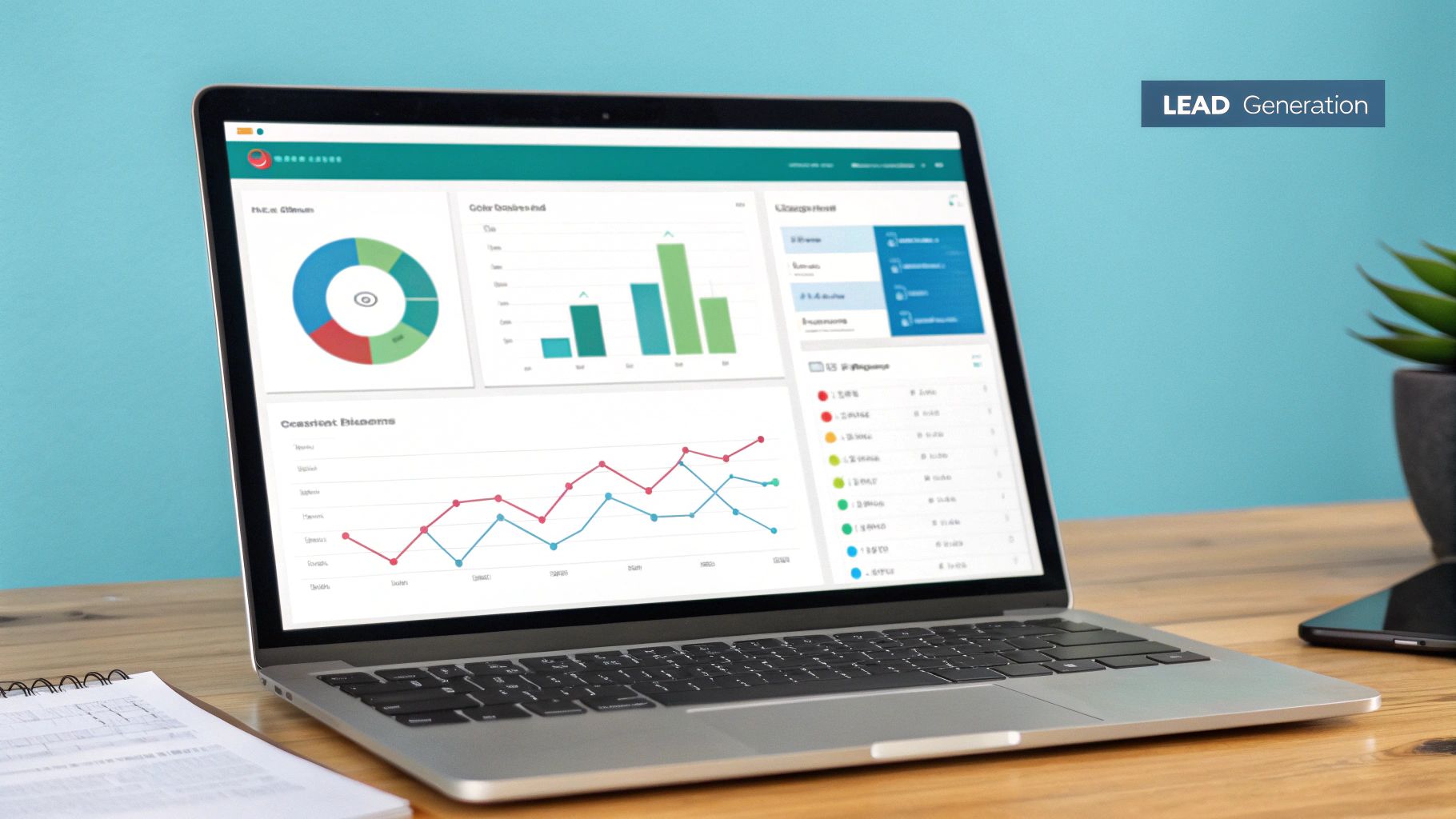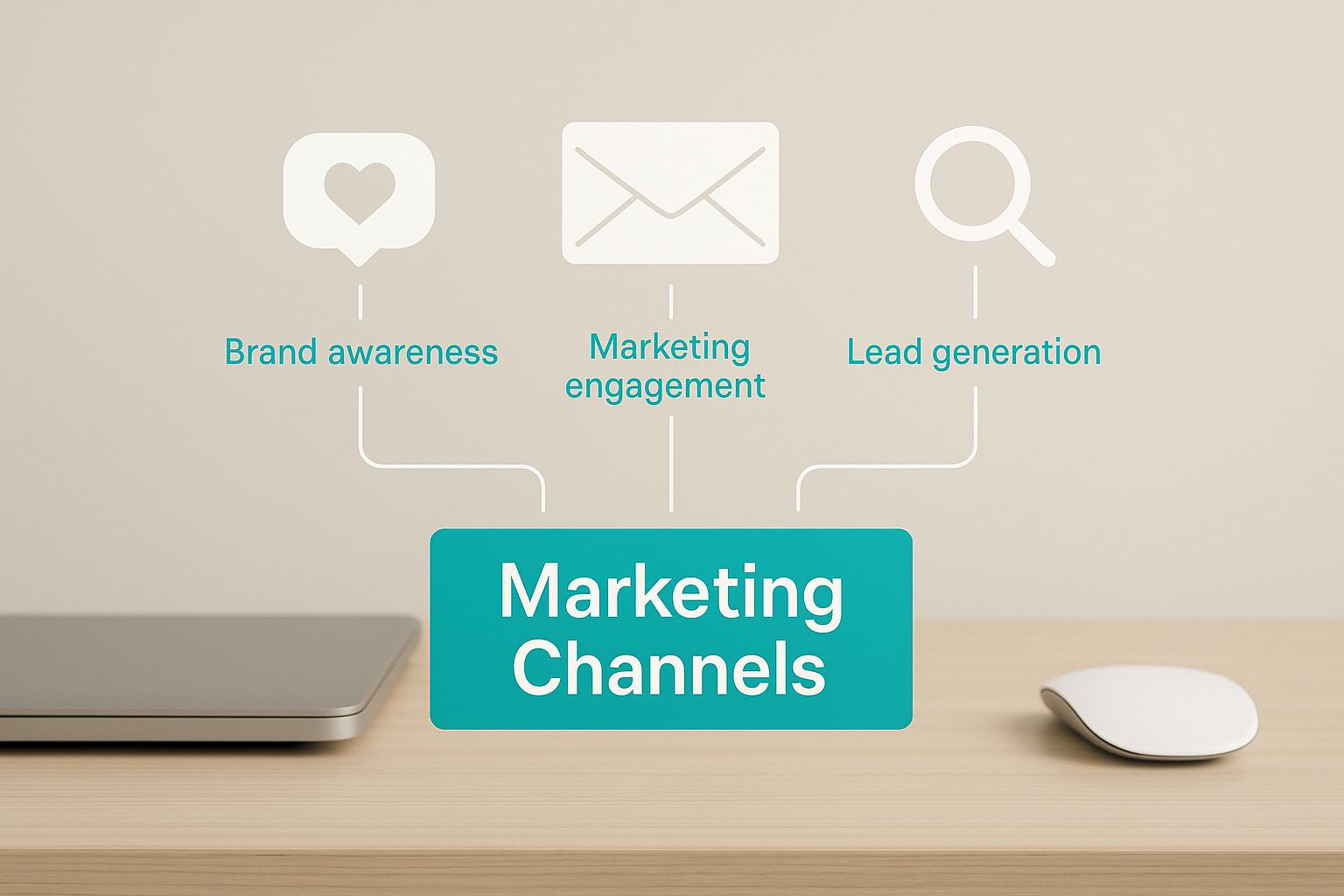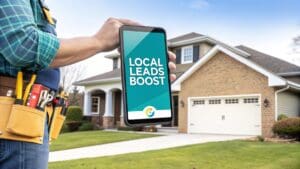Let’s be real, “lead generation marketing” sounds like something fancy and complicated. But it’s not. All it means is finding people who might be interested in what you do and starting a friendly conversation. Easy peasy.
Think of it like making new friends for your business. You don’t walk up to a stranger and immediately ask for money. That’s just weird. Instead, you find something you both like, offer to help with something, and build a little trust first. That simple idea is the secret to growing any business. You can totally do this.
What Is Lead Generation Marketing Anyway?

Imagine your business is a lemonade stand on a hot day. You’ve got the best lemonade in town, but people are walking all around, not even knowing you’re there. Lead generation marketing is you holding up a sign that says “Free Samples!”—it’s the friendly wave that invites them to come closer, have a taste, and see how awesome your lemonade is.
It’s how you turn strangers into people who are interested, or what we call “leads.” The goal isn’t to make a sale right away. It’s about offering something cool—a helpful tip, a funny video, a free checklist—to get the chat started.
Turning Strangers Into Potential Customers
Lead generation is that first handshake. It’s the simple “Hey, how’s it going?” that can start a great business relationship. You’re just looking for people who could really use your help so you can start a conversation. This is the #1 most important thing for getting new customers and growing your company.
It’s so important that a huge 91% of marketers say it’s their main goal. But here’s the crazy part: a shocking 80% of those new leads never turn into sales. What does that tell you? It’s not just about collecting names; it’s about making real friends for your business. You can look at these lead generation marketing statistics to see how many people miss this simple step.
Lead generation isn’t about building a giant list of names. It’s about building a list of potential friends—people who actually might need what you sell and are happy to hear from you.
Here’s a quick summary to make it super simple.
Lead Generation At a Glance
| Key Idea | What It Means for You |
|---|---|
| Attract, Don’t Chase | Make cool stuff that pulls people in instead of annoying them with ads. |
| Start a Conversation | Give away something helpful (like a guide or a tip) to say hello. |
| Build Trust First | Be a good, helpful person before you ever ask for a sale. |
| Find Your People | Make sure you’re talking to people who actually need what you’ve got. |
| Keep in Touch | Keep the chat going with more helpful stuff until they’re ready to buy. |
This isn’t some secret magic trick for giant companies with tons of money. It’s just about being helpful and real. It’s so much easier than it sounds.
With the right game plan—which we’re about to show you—you can start inviting the right people to your lemonade stand and turning them into happy customers who keep coming back. And we’re here to help you do it. You’ve got this!
Why Lead Generation Is a Business Game Changer

Let’s be honest for a second. Your business could be the best in the world, but if nobody knows about it, does it even exist? You can have the best service and the best team, but without customers, you’re just sitting around twiddling your thumbs.
Leads are the food that keeps your business alive. They’re the gas in the car. Without a steady stream of people interested in what you do, you can’t grow. It’s that simple. Lead generation isn’t a fancy marketing word; it’s the engine that powers your business and keeps the lights on.
Stop Shouting and Start Connecting
Ever feel like you’re just shouting into an empty room? You post something online or run an ad, crossing your fingers that someone—anyone—will notice. It’s tiring, and most of the time, it doesn’t work.
Lead generation flips that around. Instead of yelling at everyone, you start having quiet conversations with the right people. The ones who are actually looking for you.
You connect with your perfect customers—people who have a problem you can solve right now. They’re already looking for someone like you. This is a huge deal. You’re no longer a pushy salesperson; you’re a hero swooping in to save the day for someone who needs it.
Think about it this way: Lead generation is like being the only ice cream truck on the beach on a 100-degree day. You don’t have to shout; people will run to you because you have exactly what they need.
How This Saves You Time and Money
When you start getting leads the right way, you stop wasting time and money. Every dollar and every minute you spend goes toward people who are way more likely to become customers. It’s just a smarter way to do business.
Here’s how it works:
- Smarter Spending: Your marketing money isn’t a lottery ticket anymore. It goes to attract people who are already interested. No more throwing spaghetti at the wall to see what sticks.
- More Sales, Less Effort: You’re talking to people who are already warmed up, so your chances of making a sale go way, way up. One study found that businesses that help their leads along see a 50% increase in sales-ready leads for 33% less cost.
- Builds a Fan Club: This isn’t about one-time sales. By being helpful first, you build trust. You create a group of happy fans who will stick with you and tell their friends about you.
This whole process is way easier than it sounds, and you can absolutely do it. You don’t need a huge team or a boatload of cash to start. You just need to be helpful. And we can show you exactly how to do it, step-by-step. You’ve got this.
Your Toolkit for Attracting New Customers
Alright, ready to start getting new customers? Awesome. Let’s look at the tools you’ll need. Don’t worry, this isn’t about complicated gadgets or confusing instruction manuals. These are simple tools anyone can use to start a conversation with a future customer.
Think of it like fishing. You wouldn’t just throw one worm in the water and hope for the best, right? Nope. You’d bring a few different kinds of bait to see what the fish are biting. Getting leads is the exact same. You have a few simple tools, and you can pick the ones that work best for you.
This picture gives you a quick look at some of the most common ways customers can find you.

As you can see, there isn’t just one road that leads to your door. That’s why using a mix of these tools is so powerful.
Your Digital Home Base: The Website
Your website is the most important tool you have. Seriously. It’s your online store, your main office, and your front porch all in one. It’s where people go to check you out, learn what you do, and decide if they trust you with their money.
A good website doesn’t just look pretty; it works for you 24/7, even while you’re sleeping.
In fact, a giant 90.7% of marketers say their website is their number one tool for getting leads. It’s followed by blogs (89.2%) and email (69.2%), which just shows how important having a good online home is.
Your website’s main job is to make it super-duper easy for a visitor to say, “Yes, I’m interested!” This means having big, obvious contact forms, phone numbers you can click to call, and clear answers to their questions right where they can see them.
We talk more about what makes a great website in our guide to lead generation website design for home services contractors. The ideas we talk about there work for almost any local business.
The Simple Tools That Get Big Results
Besides your website, a few other simple tools can work like magic. You don’t need to be an expert in all of them. Just pick one or two to start with and go from there.
Here are the basics:
- Content Marketing: This is just a fancy way of saying “making helpful stuff.” Think of blog posts as leaving a trail of cookies that leads customers right to you. Videos, checklists, and how-to guides work great, too.
- Email Marketing: Don’t forget about email. It’s still one of the best ways to keep in touch with people who have already said they want to hear from you. It’s like having a direct phone line to people who are already interested.
- Social Media: This is your chance to show your business has a personality! Share fun behind-the-scenes photos, answer questions, and join conversations. It’s about making friends, not just yelling about sales.
- Online Ads: Running simple ads on Google or Facebook can put your business right in front of people who are looking for exactly what you sell. You set the budget, so you’re always in control. If you want to get fancier, you can even build a chatbot for lead generation to automatically talk to visitors on your site.
You can do this. The secret is to start simple, pick the right tools, and just keep at it.
Real-World Examples of Lead Generation That Actually Work
Talking about it is one thing, but seeing how real businesses get results is way more fun. Let’s look at a couple of simple stories. These aren’t giant companies with tons of money; they’re small businesses, just like yours, who used some smarts to get new customers.
You can do this, too.
Imagine a small bakery called “The Sweet Spot.” Their cupcakes were amazing, but not enough people knew they existed. Instead of spending a ton on ads, they ran a simple contest on Instagram. The prize? A dozen free cupcakes every month for a whole year.
To enter, people had to:
- Follow their Instagram page.
- Tag three friends in the comments.
- Share the post.
The result? It went bananas. Hundreds of people entered, tagging thousands of their friends. The bakery’s follower count exploded, and new customers started lining up. They didn’t just get leads; they built a whole fan club, all from one simple, fun idea.
How a Freelancer Landed Dream Clients
Now, let’s talk about Sarah, a writer. She wanted to work with cool companies but felt like she was invisible. Instead of sending out hundreds of boring emails that would just get deleted, she went to LinkedIn.
She didn’t just post her resume and wait. She started sharing short, helpful tips about writing. Quick advice, interesting articles, and smart comments on posts from companies she liked.
Soon, people from those exact companies started noticing her. Her profile views went up, people wanted to connect with her, and she landed two of her dream clients in just a few months. That’s how it works. She gave away helpful stuff first and became known as an expert who knows her stuff.
This is super powerful. LinkedIn now has over one billion users, and more than half (53%) of business-to-business marketers use it to find clients. It’s a goldmine if you know how to use it. You can read more about how businesses leverage LinkedIn for leads.
These stories prove you don’t need a huge marketing team or a complicated plan. You just need to show up where your customers are and give them a reason to pay attention.
These ideas aren’t rocket science. A local contractor or a service business can easily do the same thing as the bakery using social media ads. Our guide on running Facebook ads for local businesses shows you exactly how to reach people in your neighborhood.
You can create your own success story. Start small, be helpful, and you’ll be amazed at what happens. We’re here to help you get there.
How to Know If Your Marketing is Working (Without a Math Degree)
Alright, the leads are starting to come in. High five! But now for the big question: how do you know what’s actually working and what’s just throwing money in a bonfire?
Measuring your marketing sounds scary, but it’s not. You don’t need to be a math genius or stare at a crazy spreadsheet that makes your eyes hurt.
Think of it like this: if you’re a plumber and you try a new ad, you want to know if it made your phone ring, right? You’d check how much you spent and how many jobs it brought in. Measuring your leads is the exact same thing. It’s just paying attention to the simple numbers that tell you what’s working and what’s not.
The Only Numbers That Matter
Forget about all the confusing data. You only need to track a few key things to get a super clear picture.
Here are the most important clues to watch:
- Conversion Rate: This sounds complicated, but it’s really, really simple. It’s just the number of people who did the thing you wanted them to do. If 100 people visited your “Get a Quote” page and 10 of them actually filled it out, your conversion rate is 10%. That’s it! It’s the best way to know if your message is working.
- Cost Per Lead (CPL): How much did you pay for one person to raise their hand and say “I’m interested”? If you spend $100 on a Facebook ad and get 10 leads, your CPL is $10. This number tells you where to put your money. A lower CPL means you’re getting more leads for every dollar. Simple!
Tracking isn’t about judging yourself; it’s about getting smarter for the future. It’s like having a cheat sheet that tells you exactly where the gold is buried.
Do More of What Works (And Ditch What Doesn’t)
Once you start seeing these numbers, the next step is a piece of cake: do more of what’s working and stop wasting money on what isn’t.
If you see your blog posts are bringing in tons of cheap leads, then write more blog posts! If a Google Ad is costing you a fortune and bringing in duds, change it or turn it off.
You are in total control. The whole point of this is to learn and get better as you go, putting your time and money where it will help you the most.
It’s an awesome feeling to know exactly what makes your business grow. And you can absolutely do this. If you ever get stuck or just want someone to look over your shoulder, we’re here to help. We love making this stuff simple so you can get back to doing what you do best.
Your First Steps to Generating Leads Today
Good news. You don’t need a huge pile of money or a special degree to get started. You can start getting leads for your business right now. Today. It’s really that easy.
Think of this as your super simple guide to getting the ball rolling.
Success comes from taking small, easy steps, one after the other. Every little bit of progress is a win, and you can absolutely do this. You just have to start.
Three Simple Steps You Can Take Right Now
Ready? Here are three easy things you can do the minute you finish reading this. No confusing software or big checks needed.
- Pick One Social Media Spot: Don’t try to be everywhere at once. It’s impossible. Just pick the one place where your customers hang out (like Facebook or Instagram) and focus on it. Post something helpful a few times a week—a quick tip, a funny photo from work, or an answer to a common question. That’s it.
- Ask for a Review: Go to your last happy customer and ask them for a review. No, really. Good reviews are like magnets for new customers. They build trust instantly and show people you’re the real deal. This is one of the easiest and most powerful things you can do.
- Fix Your Website’s Contact Info: Is your phone number big, bold, and easy to click at the top of your site? Can someone find your contact form in less than three seconds? If not, fix it now. Making it super simple for people to reach you is a huge win.
The secret to getting leads isn’t knowing everything all at once. It’s about taking that first small, messy step. You’ll learn and get better as you go. You’ve got this!
If you’re ready to see how simple ads can bring in local customers, check out our easy-to-read guide on Google Ads for local businesses.
We’re cheering for you. You can do this.
Common Questions About Lead Generation
Still have a few questions? Awesome. That means you’re thinking about how to make this work for you. Let’s answer the most common ones right now.
How Much Does Lead Generation Cost?
That’s like asking, “how much does a car cost?” Are we talking about an old clunker or a shiny new sports car? It depends.
Some of the best ways to get leads are totally free, except for your time. Things like updating your Google Business Profile or posting fun pictures on social media cost you nothing.
Other things, like running ads, do cost money. But you don’t need a giant pile of cash to start. The smart way to do it is to start with the free or cheap stuff, see what works, and then put a little more money into the things that make your phone ring.
What Is the Difference Between a Lead and a Customer?
Think of it like fishing.
A lead is when you feel a little tug on your line. Someone is interested—they downloaded your guide, filled out your form, or liked your page. They see your bait, but they haven’t bitten yet.
A customer is the fish in the boat. They’ve paid you money and are officially a customer. Your job is to turn those little tugs into landed fish by being helpful, quick to respond, and trustworthy.
Lead generation is just the first “hello.” The real magic happens in the conversation that comes next, turning that first bit of interest into a paying customer.
How Long Does It Take to See Results?
This depends on what you do.
Running paid ads is like a microwave—you can get results super fast. You turn them on, and people who are looking for what you do can find you today.
Making helpful stuff—like blog posts or videos—is more like a Crock-Pot. It takes a little while to get cooking, but the results are often amazing and last for a long, long time.
Most businesses need a mix of both. But the most important thing? Just keep going. Keep showing up. The results will come. You got this.
Ready to stop guessing and start getting customers that actually pay? The Cherubini Company builds simple plans that help local businesses win. No confusing stuff, we promise. Let’s build a simple plan to grow your business today.




